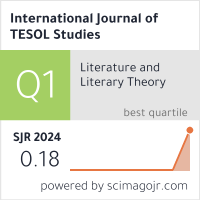2632-6779 (Print)
2633-6898 (Online)


Scopus
Ulrich’s Periodicals Directory (ProQuest)
MLA International Bibliography
MLA Directory of Periodicals
Directory of Open Access Journals (DOAJ)
QOAM (Quality Open Access Market)
British National Bibliography
WAC Clearinghouse Journal Listings
EBSCO Education
ICI Journals Master List
ERIH PLUS
CNKI Scholar
Gale-Cengage
WorldCat
Crossref
Baidu Scholar
British Library
J-Gate
ROAD
BASE
Publons
Google Scholar
Semantic Scholar
ORE Directory
TIRF
China National Center for Philosophy and Social Sciences Documentation
Tatchakrit Matyakhan
Chiang Mai University, Thailand
Ruedeerath Chusanachoti
Chulalongkorn University, Thailand
Pariwat Imsa-ard
Thammasat University, Thailand
Abstract
English oral communication is an essential skill for students’ academic achievement and social integration. Despite its pivotal role in facilitating academic participation and enabling engagement in global contexts, it remains insufficiently prioritized within general English curricula across expandingcircle higher education systems. This study presents empirical evidence from the development and evaluation of a learner-informed oral communication coursebook designed to address the functional and sociolinguistic needs of Thai university EFL students. To address this gap, the study employed a mixed-methods design guided by the ADDIE model. Data were collected through a needs analysis involving 145 undergraduates and focus group interviews with 12 experienced instructors, aiming to identify learners’ necessities, lacks, and wants in language function, linguistic competence, and sociolinguistic awareness. Findings revealed a significant mismatch between students’ perceived competence and the importance they attributed to key communicative functions, including expressing opinions, persuading, and giving suggestions. Instructors highlighted the need for communicative strategy training and the use of contextualized content to support student interaction. These insights informed the design of a six-unit coursebook, which was subsequently evaluated by five ELT experts using a structured rubric. Expert evaluations using a structured rubric yielded high ratings (M>3.25) across all five pedagogical dimensions (i.e., learning objectives, content, activities, design, and assessment), with particular strengths in task authenticity, alignment with communicative goals, and inclusion of diverse English varieties. The study contributes a replicable model for localized, needsresponsive materials development that integrates Global Englishes and learner-driven content. Pedagogically, it offers implications for curriculum designers aiming to promote real-world oral communication skills in EFL higher education contexts.
Keywords
ADDIE model, Global Englishes, learner-informed materials, materials development, needs analysis, oral communication